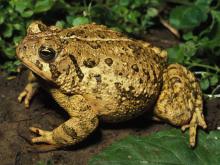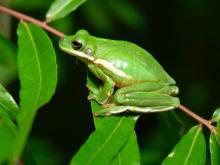Reptiles and Amphibians
Media

Species Types
Scientific Name
Coluber constrictor flaviventris (eastern yellow-bellied racer) and Coluber constrictor priapus (southern black racer)
Description
The eastern yellow-bellied racer is uniformly tan, brown, olive, blue, gray, or nearly black on top, with a yellow, cream, or light blue-gray belly. It occurs nearly statewide. The southern black racer subspecies also lives in the southeastern half of the state.
Media

Species Types
Scientific Name
Thamnophis proximus proximus
Description
The orange-striped ribbonsnake is a type of gartersnake named for the attractive orange or yellow stripes running the length of its body, alternating with wide black stripes. It is found statewide, but seldom far from water.
Media

Species Types
Scientific Name
Terrapene carolina triunguis
Description
The three-toed box turtle usually has three hind toes. Its high-domed shell usually has a top ridge and is olive or brown with faint yellow or orange lines. Look for it in woodland habitats.
Media

Species Types
Scientific Name
Lithobates sphenocephalus (formerly Rana sphenocephala)
Description
The southern leopard frog is an excellent jumper and quickly leaps into water when startled. From March through July, the males make chuckling or quacking calls from shallow water. Occurs statewide except for the northwestern corner.
Media

Species Types
Scientific Name
Anaxyrus americanus (formerly Bufo americanus)
Description
American toads are well-known and occur statewide. Missouri has two subspecies: the eastern American toad in the northern half, and the dwarf American toad in the southern half.
Media

Species Types
Scientific Name
Pseudacris crucifer
Description
The voices of spring peepers are a true announcement that winter is ending. These small, slender frogs can be several overall colors, but seeing an X on the back is a good way to ensure your identification.
Media

Species Types
Scientific Name
Gastrophryne carolinensis
Description
The eastern narrow-mouthed toad is a plump little amphibian that is seldom seen. There is a fold of skin behind its narrow, pointed head. It occurs in the southern half of the state.
Media

Species Types
Scientific Name
Anaxyrus fowleri
Description
Fowler's toad is the common toad of gravel and sand bars along our many Ozark streams and rivers. It is also the most common toad in the Bootheel lowlands.
Media

Species Types
Scientific Name
Anaxyrus woodhousii woodhousii
Description
The Rocky Mountain toad has a number of irregular dark brown or black spots on the back and a white belly. It occurs in the Missouri River floodplain, mostly from the central to the far northwestern parts of the state.
Media

Species Types
Scientific Name
Hyla cinerea (syn. Dryophytes cinereus)
Description
The bright green treefrog hides perfectly among cattail leaves, where it rests until evening. Then it begins hunting for insects. In Missouri, it occurs mostly in the Bootheel.
See Also
About Reptiles and Amphibians in Missouri
Missouri’s herptiles comprise 43 amphibians and 75 reptiles. Amphibians, including salamanders, toads, and frogs, are vertebrate animals that spend at least part of their life cycle in water. They usually have moist skin, lack scales or claws, and are ectothermal (cold-blooded), so they do not produce their own body heat the way birds and mammals do. Reptiles, including turtles, lizards, and snakes, are also vertebrates, and most are ectothermal, but unlike amphibians, reptiles have dry skin with scales, the ones with legs have claws, and they do not have to live part of their lives in water.





















